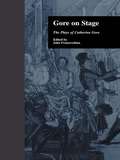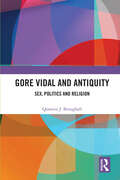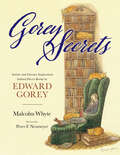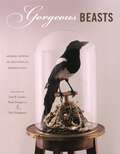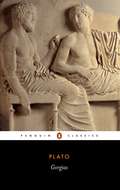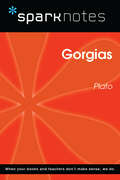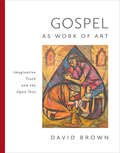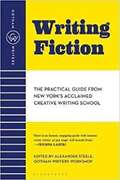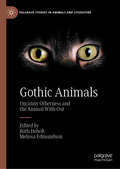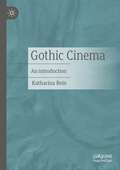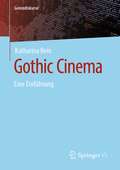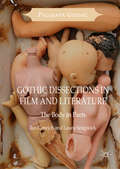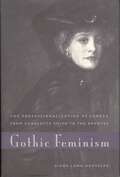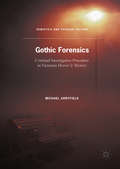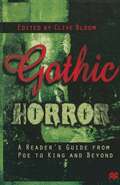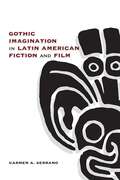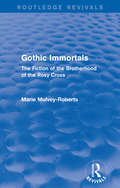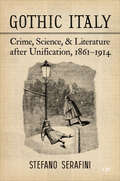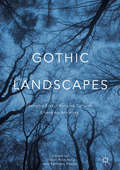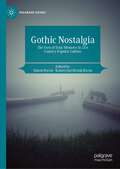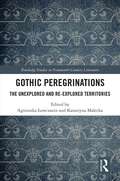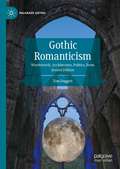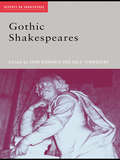- Table View
- List View
Gore On Stage: The Plays of Catherine Gore (Reference Library Of The Humanities #Vol. 2046)
by John FranceschinaFirst Published in 1999. Routledge is an imprint of Taylor & Francis, an informa company.
Gore Vidal and Antiquity: Sex, Politics and Religion
by Quentin J. BroughallThis book examines Gore Vidal’s lifelong engagement with the ancient world. Incorporating material from his novels, essays, screenplays and plays, it argues that his interaction with antiquity was central to the way in which he viewed himself, his writing, and his world. Divided between the three primary subjects of his writing – sex, politics, and religion – this book traces the lengthy dialogue between Vidal and antiquity over the course of his sixty-year career. Broughall analyses Vidal’s portrayals of the ancient past in novels such as Julian (1964), Creation (1981) and Live from Golgotha (1992). He also shows how classical literature inspired Vidal’s other fiction, such as The City and the Pillar (1948), Myra Breckinridge (1968), and his Narratives of Empire (1967–2000) novels. Beyond his fiction, Broughall examines the ways in which antiquity influenced Vidal’s careers as a playwright, an essayist and a satirist, and evaluates the influence of classical authors and their works upon him. Of interest to students and scholars in classical studies, reception studies, American politics and literature, and the work of Gore Vidal, this volume presents an original perspective on one of the most provocative writers and intellectuals in post-war American letters. It offers new insights into Vidal’s attitudes, influences, and beliefs, and throws fresh light upon his patrician self-fashioning and his mercurial output.
Gorey Secrets: Artistic and Literary Inspirations behind Divers Books by Edward Gorey
by Malcolm WhyteEdward Gorey (1925–2000) was a fascinating and prolific author and artist. Of the one hundred delightful and fascinating books that Gorey wrote and illustrated, he rarely revealed their specific inspirations or their meanings. Where did his intriguing ideas come from? In Gorey Secrets: Artistic and Literary Inspirations behind Divers Books by Edward Gorey, Malcolm Whyte utilizes years of thorough research to tell an engrossing, revealing story about Gorey’s unique works. Exploring a sampling of Gorey’s eclectic writings, from The Beastly Baby and The Iron Tonic to The Curious Sofa and Dracula, Whyte uncovers influences of Herman Melville, Agatha Christie, Edward Lear, the I Ching, William Hogarth, Rene Magritte, Hokusai, French cinema, early toy books, eighteenth-century religious tracts for children, and much more.With an enlightening preface by Gorey collaborator and scholar Peter F. Neumeyer, Gorey Secrets brings important, uncharted insight into the genius of Edward Gorey and is a welcome addition to collections of both the seasoned Gorey reader and those who are just discovering his captivating books.
Gorgeous Beasts: Animal Bodies in Historical Perspective (Animalibus)
by Paula Young Lee Joan B. Landes Paul YoungquistGorgeous Beasts takes a fresh look at the place of animals in history and art. Refusing the traditional subordination of animals to humans, the essays gathered here examine a rich variety of ways animals contribute to culture: as living things, as scientific specimens, as food, weapons, tropes, and occasions for thought and creativity. History and culture set the terms for this inquiry. As history changes, so do the ways animals participate in culture. Gorgeous Beasts offers a series of discontinuous but probing studies of the forms their participation takes. This collection presents the work of a wide range of scholars, critics, and thinkers from diverse disciplines: philosophy, literature, history, geography, economics, art history, cultural studies, and the visual arts. By approaching animals from such different perspectives, these essays broaden the scope of animal studies to include specialists and nonspecialists alike, inviting readers from all backgrounds to consider the place of animals in history and art. Combining provocative critical insights with arresting visual imagery, Gorgeous Beasts advances a challenging new appreciation of animals as co-inhabitants and co-creators of culture.Aside from the editors, the contributors are Dean Bavington, Ron Broglio, Mark Dion, Erica Fudge, Cecilia Novero, Harriet Ritvo, Nigel Rothfels, Sajay Samuel, and Pierre Serna.
Gorgeous Beasts: Animal Bodies in Historical Perspective (Animalibus: Of Animals and Cultures #2)
by Paula Young Lee Joan B. Landes Paul YoungquistGorgeous Beasts takes a fresh look at the place of animals in history and art. Refusing the traditional subordination of animals to humans, the essays gathered here examine a rich variety of ways animals contribute to culture: as living things, as scientific specimens, as food, weapons, tropes, and occasions for thought and creativity. History and culture set the terms for this inquiry. As history changes, so do the ways animals participate in culture. Gorgeous Beasts offers a series of discontinuous but probing studies of the forms their participation takes. This collection presents the work of a wide range of scholars, critics, and thinkers from diverse disciplines: philosophy, literature, history, geography, economics, art history, cultural studies, and the visual arts. By approaching animals from such different perspectives, these essays broaden the scope of animal studies to include specialists and nonspecialists alike, inviting readers from all backgrounds to consider the place of animals in history and art. Combining provocative critical insights with arresting visual imagery, Gorgeous Beasts advances a challenging new appreciation of animals as co-inhabitants and co-creators of culture.Aside from the editors, the contributors are Dean Bavington, Ron Broglio, Mark Dion, Erica Fudge, Cecilia Novero, Harriet Ritvo, Nigel Rothfels, Sajay Samuel, and Pierre Serna.
Gorgias
by PlatoTaking the form of a dialogue between Socrates, Gorgias, Polus and Callicles, GORGIAS debates perennial questions about the nature of government and those who aspire to public office. Are high moral standards essential or should we give our preference to the pragmatist who gets things done or negotiates successfully? Should individuals be motivated by a desire for personal power and prestige, or genuine concern for the moral betterment of the citizens? These questions go to the heart of Athenian democratic principles and are more relevant than ever in today's political climate.
Gorgias (SparkNotes Philosophy Guide)
by SparkNotesGorgias (SparkNotes Philosophy Guide) Making the reading experience fun! SparkNotes Philosophy Guides are one-stop guides to the great works of philosophy–masterpieces that stand at the foundations of Western thought. Inside each Philosophy Guide you&’ll find insightful overviews of great philosophical works of the Western world.
Gospel as Work of Art: Imaginative Truth and the Open Text
by David BrownA lushly illustrated, magisterial exploration of the imaginative truth of the gospel In the modern academy, truth and imagination are thought to be mutually exclusive. But what if truth can spring from other fonts, like art, literature, and invention? The legacy of the Enlightenment favors historical and empirical inquiry above all other methods for searching for truth. But this assumption stymies our theological explorations. Though the historicity of Jesus&’s life, death, and resurrection is important, it is not of sole importance. For instance, is John&’s Gospel any less &“true&” than the Synoptics just because it&’s less historically accurate? David Brown challenges us to expand our understanding of the gospel past source criticism and historical Jesus studies to include works of imagination. Reading Scripture in tandem with works of art throughout the centuries, Brown reenvisions the gospel as an open text. Scholars of theology and biblical studies, freed from literalism, will find new avenues of revelation in Gospel as Work of Art. This volume includes over one hundred color illustrations.
Gotham Writers' Workshop: The Practical Guide From New York's Acclaimed Creative Writing School
by Nikki Moustaki Gotham Writers' WorkshopHere you'll find: The fundamental elements of fiction craft―character, plot, point of view, etc.―explained clearly and completely - Key concepts illustrated with passages from great works of fiction - The complete text of "Cathedral" by Raymond Carver―a masterpiece of contemporary short fiction that is analyzed throughout the book - Exercises that let you immediately apply what you learn to your own writing. Written by Gotham Writers' Workshop expert instructors and edited by Dean of Faculty Alexander Steele, Writing Fiction offers the same methods and exercises that have earned the school international acclaim. Once you've read―and written―your way through this book, you'll have a command of craft that will enable you to turn your ideas into effective short stories and novels. You will be a writer. Gotham Writers' Workshop is America's leading private creative writing school, offering classes in New York City and on the web at WritingClasses.com. The school's interactive online classes, selected "Best of the Web" by Forbes, have attracted thousands of aspiring writers from across the United States and more than sixty countries.
Gothic Animals: Uncanny Otherness and the Animal With-Out (Palgrave Studies in Animals and Literature)
by Melissa Edmundson Ruth HeholtThis book begins with the assumption that the presence of non-human creatures causes an always-already uncanny rift in human assumptions about reality. Exploring the dark side of animal nature and the ‘otherness’ of animals as viewed by humans, and employing cutting-edge theory on non-human animals, eco-criticism, literary and cultural theory, this book takes the Gothic genre into new territory. After the dissemination of Darwin’s theories of evolution, nineteenth-century fiction quickly picked up on the idea of the ‘animal within’. Here, the fear explored was of an unruly, defiant, degenerate and entirely amoral animality lying (mostly) dormant within all of us. However, non-humans and humans have other sorts of encounters, too, and even before Darwin, humans have often had an uneasy relationship with animals, which, as Donna Haraway puts it, have a way of ‘looking back’ at us. In this book, the focus is not on the ‘animal within’ but rather on the animal ‘with-out’: other and entirely incomprehensible.
Gothic Cinema: An introduction
by Katharina ReinGothic Cinema closes a gap in German-language film discourse: for the first time, the volume sheds light on a hitherto little-discussed film context. It considers Gothic Cinema as a form of unofficial historiography that allows a look not only at the history of film and its technique, but also at moral concepts, gender relations, collective fears or aesthetic currents. A delimitation and definition of the term and the central elements of the Gothic are followed by a comprehensive historical overview from 1896 to the present day. Three in-depth analyses of individual post-2015 gothic films and television series round out the review. On the one hand, the examples examined are representative in terms of typical elements, motifs or topoi, and on the other hand, they exhibit peculiarities and breaks that prove fruitful for a cultural and media studies investigation.
Gothic Cinema: Eine Einführung (Genrediskurse)
by Katharina ReinMit Gothic Cinema schließt sich eine Lücke im deutschsprachigen Filmdiskurs: Erstmalig beleuchtet der Band einen bislang wenig diskutierten Filmzusammenhang. Er betrachtet das Gothic Cinema als als eine Form inoffizieller Historiographie, die einen Blick nicht nur auf die Geschichte des Films und seiner Technik, sondern auch auf Moralvorstellungen, Geschlechterverhältnisse, kollektive Ängste oder ästhetische Strömungen zulässt. Auf eine Abgrenzung und Bestimmung des Begriffs und der zentralen Elemente des Gothic folgt ein umfassender historischer Überblick von 1896 bis zur heutigen Zeit. Drei ausführliche Analysen einzelner Gothic-Filme und Fernsehserien nach 2015 runden die Betrachtung ab. Die untersuchten Beispiele sind einerseits repräsentativ im Hinblick auf typische Elemente, Motive oder Topoi und weisen andererseits Besonderheiten und Brüche auf, die sich für eine kultur- und medienwissenschaftliche Untersuchung als fruchtbar erweisen.
Gothic Dissections in Film and Literature
by Ian Conrich Laura SedgwickThis is the first book-length study to systematically and theoretically analyse the use and representation of individual body parts in Gothic fiction. Moving between filmic and literary texts and across the body--from the brain, hair and teeth, to hands, skin and the stomach--this book engages in unique readings by foregrounding a diversity of global representations. Building on scholarly work on the 'Gothic body' and 'body horror', Gothic Dissections in Film and Literature dissects the individual features that comprise the physical human corporeal form in its different functions. This very original and accessible study, which will appeal to a broad range of readers interested in the Gothic, centralises the use (and abuse) of limbs, organs, bones and appendages. It presents a set of unique global examinations; from Brazil, France and South Korea to name a few; that address the materiality of the Gothic body in depth in texts ranging from the nineteenth century to the present; from Nikolai Gogol, Edgar Allan Poe, Roald Dahl and Chuck Palahniuk, to David Cronenberg, Freddy Krueger and The Greasy Strangler.
Gothic Feminism: The Professionalization of Gender from Charlotte Smith to the Brontës (G - Reference, Information and Interdisciplinary Subjects)
by Diane Long HoevelerAs British women writers in the late eighteenth and early nineteenth centuries sought to define how they experienced their era's social and economic upheaval, they helped popularize a new style of bourgeois female sensibility. Building on her earlier work in Romantic Androgyny, Diane Long Hoeveler now examines the Gothic novels of Charlotte Smith, Ann Radcliffe, Jane Austen, Charlotte Dacre Byrne, Mary Shelley, and the Brontës to show how these writers helped define femininity for women of the British middle class.Hoeveler argues that a female-created literary ideology, now known as "victim feminism," arose as the Gothic novel helped create a new social role of professional victim for women adjusting to the new bourgeois order. These novels were thinly disguised efforts at propagandizing a new form of conduct for women, teaching that "professional femininity"—a cultivated pose of wise passiveness and controlled emotions—best prepared them for social survival. She examines how representations of both men and women in these novels moved from the purely psychosexual into social and political representations, and how these writers constructed a series of ideologies that would allow their female characters—and readers—fictitious mastery over an oppressive social and political system.Gothic Feminism takes a neo-feminist approach to these women's writings, treating them not as sacred texts but as thesis-driven works that attempted to instruct women in a series of strategic poses. It offers both a new understanding of the genre and a wholly new interpretation of feminism as a literary ideology.
Gothic Forensics
by Michael ArntfieldMichael Arntfield interrogates the legacy of Victorian-era crime fiction and Gothic horror on investigative forensic methods used by police today.
Gothic Horror: A Guide for Students and Readers
by Clive BloomThis highly accessible anthology of Gothic writings and criticism provides an essential guide to the genre. The second edition of this critically acclaimed book has been thoroughly revised to include material from the early gothic and a fresh set of contemporary essays, with a supporting timeline and thought provoking introductory material.
Gothic Imagination in Latin American Fiction and Film
by Carmen A. SerranoThis work traces how Gothic imagination from the literature and culture of eighteenth- and nineteenth-century Europe and twentieth-century US and European film has impacted Latin American literature and film culture. Serrano argues that the Gothic has provided Latin American authors with a way to critique a number of issues, including colonization, authoritarianism, feudalism, and patriarchy. The book includes a literary history of the European Gothic to demonstrate how Latin American authors have incorporated its characteristics but also how they have broken away or inverted some elements, such as traditional plot lines, to suit their work and address a unique set of issues. The book examines both the modernistas of the nineteenth century and the avant-garde writers of the twentieth century, including Huidobro, Bombal, Rulfo, Roa Bastos, and Fuentes. Looking at the Gothic in Latin American literature and film, this book is a groundbreaking study that brings a fresh perspective to Latin American creative culture.
Gothic Immortals (Routledge Revivals): The Fiction of the Brotherhood of the Rosy Cross
by Marie Mulvey-RobertsFirst published in 1990, this book represents the first full-length study of into the group of novels designated ‘Rosicrucian’ and traces the emergence of this distinct fictional genre, revealing a continuous occult tradition running through seemingly diverse literary texts. Taking the Enlightenment as a starting point, the author shows how the physician’s secular appropriation of the idea of eternal life, through the study of longevity and physical decay, attracted writers like William Godwin. It focuses on the bodily immortality of the Rosicrucian hero and investigates the novels of five major writers — Godwin, Percy Bysshe Shelley, Mary Shelley, Maturin, and Bulwer-Lytton.
Gothic Italy: Crime, Science, and Literature after Unification, 1861–1914 (Toronto Italian Studies)
by Stefano SerafiniThe Gothic, proliferating across different literary, socio-cultural, and scientific spaces, permeated and influenced the project of Italian nation-building, casting a dark and pervasive shadow on Italian history. Gothic Italy explores the nuances, contradictions, and implications of the conflict between what the Gothic embodies in post-unification Italy and the values that a supposedly secular, modern country tries to uphold and promote. The book analyses a variety of literary works concerned with crime that tapped into fears relating to contagion, race, and class fluidity; deviant minds and abnormal sexuality; female transgression; male performativity; and the instability of the new body politic. By tracing how writers, scientists, and thinkers engaged with these issues, Gothic Italy unveils the mutual network of exchanges that informed national discourses about crime. Stefano Serafini brings attention to a historical moment that was crucial to the development of modern attitudes towards normality and deviance, which continue to circulate widely and still resonate disturbingly in contemporary society.
Gothic Landscapes
by Sharon Rose Yang Kathleen HealeyThis book is about the ways that Gothic literature has been transformed since the 18th century across cultures and across genres. In a series of essays written by scholars in the field, the book focuses on landscape in the Gothic and the ways landscape both reflects and reveals the dark elements of culture and humanity. It goes beyond traditional approaches to the Gothic by pushing the limits of the definition of the genre. From landscape painting to movies and video games, from memoir to fiction, and from works of different cultural origins and perspectives, this volume traverses the geography of the Gothic revealing the anxieties that still haunt humanity into the twenty-first century.
Gothic Nostalgia: The Uses of Toxic Memory in 21st Century Popular Culture (Palgrave Gothic)
by Simon Bacon Katarzyna Bronk-BaconThis book is an original and innovative study of how Gothic nostalgia and toxic memory are used to underpin and promote the ongoing culture wars and populist politics in contemporary popular culture. The essays collected here cover topics from the spectral to the ecological, deep fakes to toxic ableism, Mary Poppins to John Wick to reveal how the use of an imaginary past to shape the present, creates truly Gothic times that we can never escape. These ‘hungry ghosts’ from the past find resonance with the Gothic which speaks equally of a past that often not only haunts the present but will not let it escape its grasp. This collection will look at the confluence between various kinds of toxic nostalgia and popular culture to suggest the ways in which contemporary populism has resurrected ideological monsters from the grave to gorge on the present and any possibility of change that the future might represent.
Gothic Peregrinations: The Unexplored and Re-explored Territories (Routledge Studies in Nineteenth Century Literature)
by Agnieszka Lowczanin Katarzyna MaleckaFor over two hundred years, the Gothic has remained fixed in the European and American imaginations, steadily securing its position as a global cultural mode in recent decades. The globalization of Gothic studies has resulted in the proliferation of new critical concepts and a growing academic interest in the genre. Yet, despite its longevity, unprecedented expansion, and accusations of prescriptiveness, the Gothic remains elusive and without a straightforward definition. Gothic Peregrinations: The Unexplored and Re-explored Territories looks at Gothic productions largely marginalized in the studies of the genre, including the European absorption of and response to the Gothic. This collection of essays identifies landmarks and ley lines in the insufficiently probed territories of Gothic scholarship and sets out to explore its unmapped regions. This volume not only examines Gothic peregrinations from a geographical perspective but also investigates how the genre has been at odds with strict demarcation of generic boundaries. Analyzing texts which come from outside the Gothic canon, yet prove to be deeply indebted to it, like bereavement memoirs, stories produced by and about factory girls of Massachusetts, and the Mattel Monster High franchise, this volume illuminates the previously unexplored fields in Gothic studies. The chapters in this volume reveal the truly transnational expansion of the Gothic and the importance of exchange – exchange now seen not only as crucial to the genre’s gestation, or vital to the processes of globalization, but also to legitimizing Gothic studies in the global world.
Gothic Romanticism: Wordsworth, Architecture, Politics, Form (Palgrave Gothic)
by Tom DuggettGothic Romanticism: Wordsworth, Architecture, Politics, Form offers a revisionist account of both Wordsworth and the politics of antiquarianism in the late eighteenth and early nineteenth centuries. As a historically-driven study that develops a significant critique and revision of genre- and theory-based approaches to the Gothic, it covers many key works by Wordsworth and his fellow “Lake Poets” Samuel Taylor Coleridge and Robert Southey. The second edition incorporates new materials that develop the argument in new directions opened up by changes in the field over the last decade. The book also provides a sustained reflection upon Romantic conservatism, including the political thought and lasting influence of Edmund Burke. New material places the book in wider and longer context of the political and historical forms seen developing in Wordsworth, and proposes Gothic Romanticism as the alternative line of cultural development to Victorian Medievalism.
Gothic Science Fiction
by Sian MacarthurGothic Science Fiction is a comprehensive account of the rise of a fascinating genre that has grown out of the Gothic. From the dark and mysterious world of mad scientists to the horrors and terrors associated with monsters and aliens, Sian MacArthur takes the reader through a madcap journey to identify those features of the Gothic that have influenced and continue to influence the world of science fiction. From Frankenstein to Doctor Who and from H. G Wells to Stephen King, the book explores several aspects, beginning with Mary Shelley and bringing the subject matter right up to date with the inclusion of works by Justin Cronin and Daniel Wilson. Gothic Science Fiction gives the crazy and always interesting world of Gothic science fiction detailed attention in an account that is both accessible and engaging.
Gothic Shakespeares (Accents on Shakespeare #10)
by Dale Townshend John DrakakisReadings of Shakespeare were both influenced by and influential in the rise of Gothic forms in literature and culture from the late eighteenth century onwards. Shakespeare’s plays are full of ghosts, suspense, fear-inducing moments and cultural anxieties which many writers in the Gothic mode have since emulated, adapted and appropriated. The contributors to this volume consider: Shakespeare’s relationship with popular Gothic fiction of the eighteenth century how, without Shakespeare as a point of reference, the Gothic mode in fiction and drama may not have developed and evolved in quite the way it did the ways in which the Gothic engages in a complex dialogue with Shakespeare, often through the use of quotation, citation and analogy the extent to which the relationship between Shakespeare and the Gothic requires a radical reappraisal in the light of contemporary literary theory, as well as the popular extensions of the Gothic into many modern modes of representation. In Gothic Shakespeares, Shakespeare is considered alongside major Gothic texts and writers – from Horace Walpole, Ann Radcliffe, Matthew Lewis and Mary Shelley, up to and including contemporary Gothic fiction and horror film. This volume offers a highly original and truly provocative account of Gothic reformulations of Shakespeare, and Shakespeare’s significance to the Gothic. Contributors include: Fred Botting, Elizabeth Bronfen, Glennis Byron, Sue Chaplin, Steven Craig, John Drakakis, Michael Gamer, Jerrold Hogle, Peter Hutchings, Robert Miles, Dale Townshend, Scott Wilson and Angela Wright.
